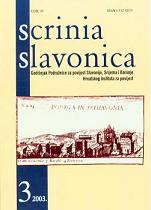
Bibliography on Vukovar in Homeland War
Bibliografija radova o Vukovaru u Domovinskom ratu
Keywords: Vukovar; Homeland war 1991-1992
Bibliography on Vukovar in Homeland War
More...
Keywords: Vukovar; Homeland war 1991-1992
Bibliography on Vukovar in Homeland War
More...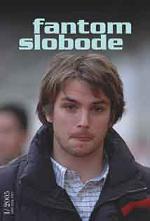
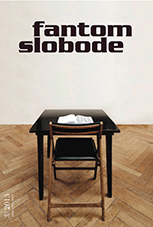
Vozdra, čovjeci obaju spolova! Našu malu zajednicu kanda je onaj vaš Nietzsche inficirao vječnim vraćanjem istog. Jerbo gazdarica i opet izvrdava pisaniju, sada o (jednoj) profesiji si svojoj — onoj uredničkoj — i preuzeti radni zadatak uvaljuje meni. Za one koji to slučajno ne znaju: identično se, naime, ponijela kad ju je čika Vinko Brešić iskao autobiografski (za)pisak. Ja sam vam, međutim, mačak dobro— i velikodušan, a s druge strane realističan (krov nad glavom & repom, klopa à la carte i čika Aco Stojanovski, velemajstor veterinarstva, ne rastu baš na svakoj kruški, jebiga), pa ću joj i ovaj put odraditi lavovski dio posla.
More...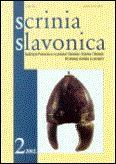
MIRKO MARKOVIĆ, Slavonija – Povijest naselja i podrijetlo stanovništva (Zagreb: Golden Marketing, 2002), 614 str. BORIS NIKŠIĆ, Osmansko Carstvo 17. stoljeća očima bivšeg zarobljenika (Zagreb: Hrvatski institut za povijest, 2001), 181 str. FRANJO EMANUEL HOŠKO, Franjevci i poslanje Crkve u kontinentalnoj Hrvatskoj. Analecta Croatica christiana, sv. 34 (Zagreb: Kršćanska sadašnjost, 2001), 495 str. ANTUN STOJANOVIĆ, Opisanje mog života. Memoarski zapis o Osijeku (1822.-1866.), priredio Stanislav Marijanović (Osijek: Matica hrvatska, 2000). STJEPAN MATKOVIĆ, Čista stranka prava 1895.-1903. (Zagreb: Hrvatski institut za povijest, 2001), 417 str. MIRA KOLAR-DIMITRIJEVIĆ, Skrivene biografije nekih Nijemaca i Austrijanaca u Hrvatskoj 19. i 20. stoljeća (Osijek: Njemačka narodnosna zajednica, 2001), 330 str. BORISLAV BIJELIĆ, Naše teme. Ogledi o prošlosti i sadašnjosti Đakova i Đakovštine (Đakovo: Muzej Đakovštine, 2002.), 234 str., ilustr. VLADIMIR GEIGER, Nijemci u Đakovu i Đakovštini (Zagreb: Hrvatski institut za povijest i Dom i svijet, 2001), 231 str. VLADIMIR GEIGER, Radni logor Valpovo 1945.-1946. (Osijek: Njemačka narodnosna zajednica i Zemaljska udruga Podunavskih Švaba, 1999), 443 str. BRANKO BEŠLIN, Vesnik tragedije. Nemačka štampa u Vojvodini 1933-1941. godine, (Novi Sad i Sremski Karlovci: Izdavačka agencija Platoneum i Izdavačka knjižarnica Zorana Stojanovića, 2001), 263 str., ilustr. ANDRÉ GEROLYMATOS, The Balkan Wars: Myth, Reality, and the Eternal Conflict (Toronto: Stoddart, 2001), 297 str. Zbornik Muzeja Đakovštine, br. 5 (Đakovo, 2001), 306 str. Acta historico-oeconomica. Časopis za ekonomsku povijest, sv. 27 (Zagreb, 2000), 216 str.
More...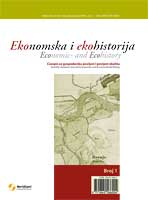
Keywords: Podravina; ecohistory; Ottoman Empire
The part of the Podravina region under Ottoman rule was not very homogenous in the administrative, ethnic and religious sense. More than in other confines the borders between the proper borderland and the “civilian” part were extremely fluid, thus producing a kind of “multiple subconfines”. There were probably less inhabitasnts than in the late Middle Ages, which points toward the expansion of forest areas, also suggested by the sources, and, at the same time, toward the increased exploitation of the woods (timber and acorns). Ottoman conquest and the military factor have left a considerable imprint on the landscape (Vlach pastoralization, forced grain production in the flatland), while in the strongholds and marketplaces, notwithstanding the appearance of the mosques as signs of Ottoman-islamic presence, changes were less prominent. The names of places did not considerably change in the 16th century, but later, particularly toward the end of the 17th century, they did to the large extant. Centers of raw material processing (milling), ways of export (wheat, fruit, pigs, slaves) as well the centers of provisioning (wares from the fairs), were all relocated to the southeast (Orahovica, Našice), or to the Middle Danube region (Valpovo and Osijek). The only important regional center was Virovitica, where probably half of the commercial activities of the region were taking place, but the sources give us only some indirect hints thereof.
More...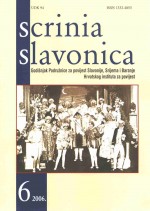
Keywords: Stjepan Vukovac; Osijek; Independent State of Croatia (NDH); Ministry of the Interior.
There have been few records in Croatian historiography of Stjepan Vukovac, the Mayor of Osijek and Assistant Minister of Interior Affairs of the Independent State of Croatia (a position which very soon he abandoned). This paper sets out to illuminate, on the basis of historiographic data, the role and activities of Stjepan Vukovac, the mayor of Osijek at the time of the establishment of the Independent State of Croatia in April 1941. Special attention is paid to his entrance into and activities within the Government of the Independent State of Croatia, and to the reasons leading to his resignation in June 1941. On assuming the position of Assistant Minister of Interior Affairs, Stjepan Vukovac entered into conflict with Eugen Dido Kvaternik, and at this earliest stage of his mandate, voiced his disagreement with the current regime. As the state secretary and assistant minister, Vukovac told the ustasha official from Karlovac, Vladimir Židovac that “even though there have only been a few isolated cases so far, one must conclude that Dido Kvaternik and the other competent «figures» are preparing to wage a full scale war against the Serbs and the Jews to their complete annihilation”. Soon enough, Vukovac’s premonitions proved true; towards the end of June the most massive wave of arrests was launched. It must be stressed that the persecution of the Serbs, Jews but also of different-minded Croatians, produced a state of chaos in the Independent State of Croatia since its very inception. Persecutions of Serbs were a part of Pavelić’s planned agenda, which he started implementing aided by around 250 returned Ustashas. Such ustashas were sent off to different regions and places with the purpose of persecuting the Serbs and terrorizing the Croats who did not share their political views. Under the German pressure, some anti-Semitic laws were also passed and the persecution of Jews began. However, at lower administrative levels of the ustasha movement and the government there were quite a few officials who distanced themselves from the ruling regime and from their particular actions, and who resigned from their positions or cancelled their memberships. Among the higher structures of central government, such examples were few, but one notable example, beyond doubt, is Stjepan Vukovac.
More...Keywords: Military frontier; Slavonia; explotations of the forests
More...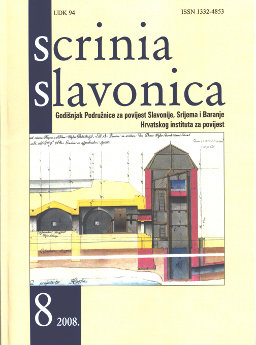
Keywords: Mühimme defters; Slavonija; Srijem
Croatian translation of Mühimme defter from the year 1552.
More...Il contributo analizza la lingua di una breve commedia apparsa nel volume XXV (1992) dell'Antologia delle opere premiate Istria Nobilissima (Trieste), che si svolge a Gallesano nell'area istroromanza (IR) dell'Istria sudoccidentale ed è scritta in un dialetto che presenta alcuni tratti tipici del gallesanese. In tal modo ai tre maggiori dialetti IR finora presenti nell'Antologia, quelli di Rovigno, Dignano e Valle, viene ad aggiungersi adesso il gallesanese. Per questa varietà IR dopo il libro I dialetti ladino-veneti dell'Istria di Antonio Ive, risalente al 1900, non si avevano materiali. Il confronto di due sincronie a distanza praticamente di un secolo rivela sia conservazioni che interessanti innovazioni, nonché le inevitabili interferenze tra IR e veneto istriano. I due idiomi coesistono nel testo in distribuzione funzionale.
More...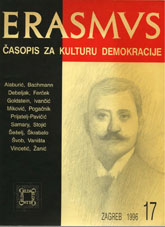
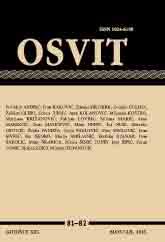
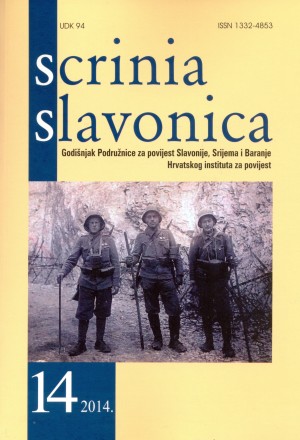
Keywords: Ottoman Empire; Sanjak of Požega; kasaba of Đakovo; vaqf; Ottoman officials, Benlu-aga
The document regarding the kasaba (town) of Đakovo, found by accident, as part of a mecmua (miscellany) in the Gazi Husrev-beg Library in Sarajevo, gives significant data supplementing our knowledge of and illuminating the time of the Ottoman rule in this kasaba. The document originates from a sicil, court register, and thus it is completely reliable. This document examines the condition of a facility included in the legacy of Benlu-aga, the kehaya (steward) of the prominent Lala (educator, teacher) Kara Mustafa Pasha. Benlu-aga is a name already known in the cadastral registers of the Sanjak of Požega (Pojega) from 1565 and 1579. These registers certify that Benlu-aga erected a mescit (small mosque) in Đakovo. No other data concerning the building or its legator can be found in the defters (tax registers). This is why this newly found document is very significant; it provides detailed data on the legator as well as on his waqf. According to this document it has become apparent that the waqf was bigger and composed of multiple buildings. The document gives information about the hamam – public town bath, not mentioned in cadastral registers. During that time, in the year 1580, the hamam was already in poor condition and its further fate was called into question. Since experts had estimated that for repair works a great amount of money, 100.000 akçe (Ottoman currency unit), would be needed, it was decided that repair works would not be undertaken due to the lack of financial means from the waqf. The fact that such an amount of money was required for the repair works indicates that the hamam must have been a rather solid object of high quality. Nevertheless, because of the lack of money, it was decided to sell the remains of the hamam and its plot for 30.000 akçe; the money was placed at the disposal of the waqf fund and made available for further needs of the population. According to Islamic law, such an action was considered legal due to the fact that the property was not alienated, only its purpose had been altered.
More...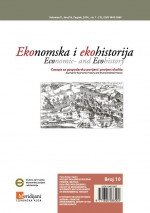
Ivan Erceg's Bibliography (1953 - 2006)
More...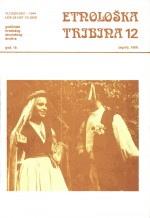
Keywords: seasonality of marriage; northern Croatia; 18th and 19th centuries; migration from the Balkan; cultural anthropology;
The author has analyzed spatial distribution of seasonality of marriage in north and central Croatia in the 18th and 19th centuries. She has found that in north-west Croatia, until the middle of the 19th century, the season with the highest number of contracted marriages was winter. Starting from the 1830s, a secondary, autumn maximum emerged. In the north-east Croatia, autumn had been and remained the principal marriage season in the 18th and 19th centuries. A mixture of both maxima was located in central Croatia, especially along the border of the regions with different marriage seasons. The territory of northern Croatia can be fitted quite well into the European context At the end of the 19th century the surrounding countries had all a mixture of autumn and winter marriage season. The north-west of Croatia was contiguous to the pattern of those northern and north-west areas with the winter maximum (Hungary, Slovene countries, Italy), while the north-east of Croatia bordered on the pattern of those southern and eastern areas with the domination of the autumn maximum (Bosnia and Herzegovina, Serbia and Greece). The spatial distribution of the season of marriage in southern Europe does not help explain the observed distribution of the two patterns in northern Croatia. Economic and religious moments are insufficient, too. The author has attempted to explain the difference in the time of marriage between west and east of northern Croatia by looking at population movements from the Balkan peninsula to the north, from the 16th to the 18th centuries. She has made a claim that the settlers to north-east Slavonia either brought a completely new pattern of the season of marriage (the implication being that all of north Croatia previously had the same marriage season — winter) or reinforced the already existing pattern (with the implication that there had been a difference in the marriage season between north-west and north-east Croatia even before large migrations of the period between the 16th and 18th centuries).
More...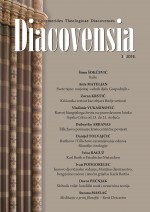
Keywords: Đakovo; Theological Seminary; Ivan Krapac; Josip Vancaš; Dionis Sunko; neo-styles; Secession; Art Deco; folklore motifs;
The Diocesan Seminary in Đakovo was situated in the Baroque building of the former Franciscan monastery for more than a century. In 1908 the architect Josip Vancaš (born in Sopron, Hungary, in 1859; died in Zagreb in 1932) made the project of the full adaptation of the Seminary. However, in 1911 a decision was made to build a completely new building. The project was developed by Dionis Sunko, architect from Zagreb (Sisak, 1879 – Zagreb 1935). Sunko managed to functionally include different aspects of the seminary life. Certain spatial solutions, primarily the one made for the façade and the interior, showed the architect’s exquisite sensibility for the context. He respected the local folklore tradition and, according to his own words, the vicinity of the Bishop’s Palace had inspired him to use the elements of Baroque formative style. In the interior design and the details on the façade we can find certain Secession motifs as well as those close to Art Deco suggestive style expression. This audacious combination of the elements of various styles is unique in the Croatian architecture of the fi rst decades of the 20th century.
More...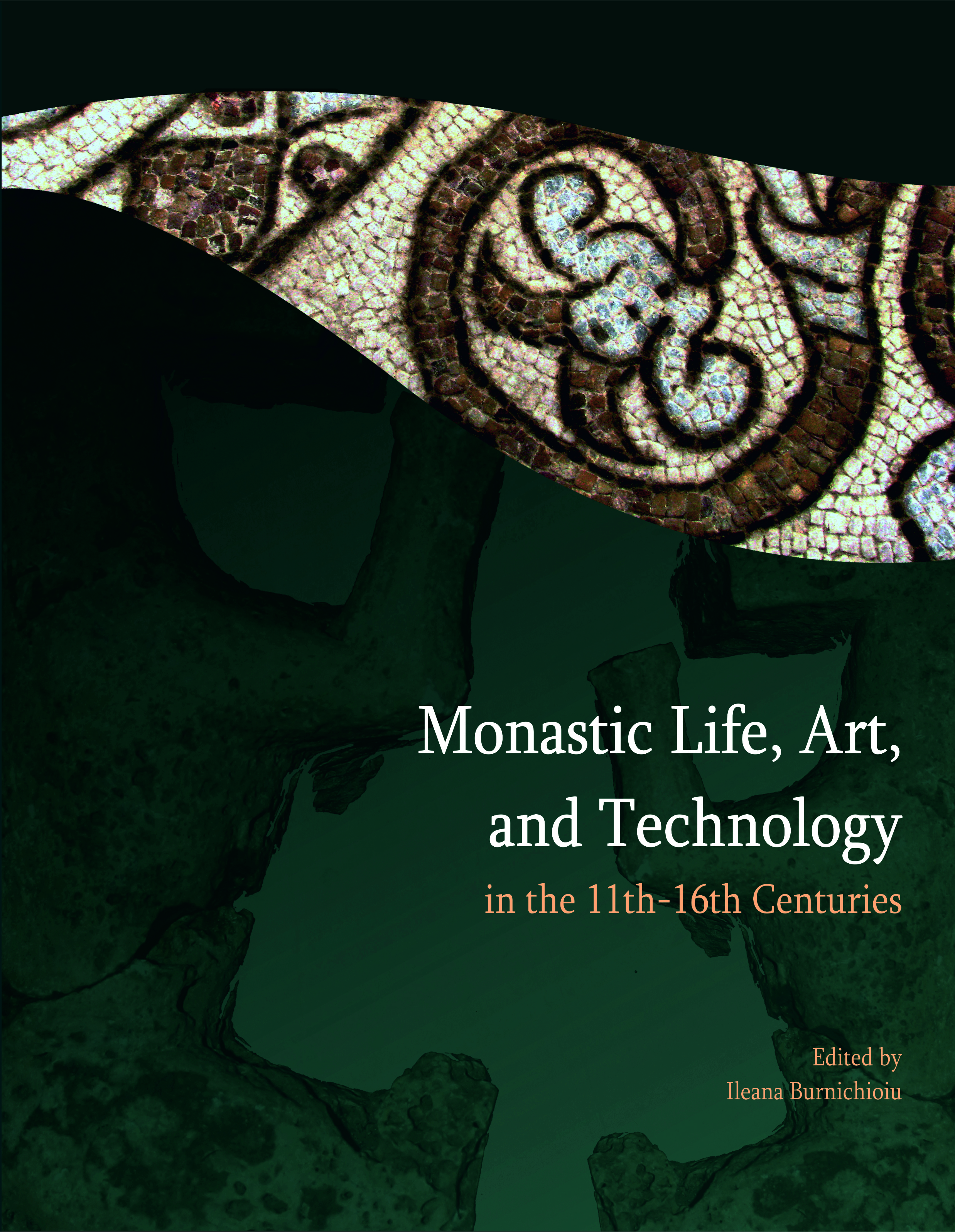
Keywords: monastic landscape; Bijela Abbey; Benedictine Order;
The remains of the Benedictine abbey of St. Margaret are situated 500 m south of the village Bijela, south-east of Daruvar (central Croatia), on a 120 m long and 85 m wide oval elevation. On the south-eastern side, the hill sharply descends into the Brzica Stream.During the fourteenth and fifteenth centuries, the Benedictine Monastery of St. Margaret, on the western slopes of Papuk, was one of the order's most important centers in medieval Slavonia. Although the exact date of the foundation and construction of the monastic complex is still unknown, Bijela Abbey has the best recorded history. The number of known documents mentioning the monastery, from only ten in the fourteenth century increases significantly to a total of seventy in the fifteenth and sixteenth century, documenting the transformation of a priory into a flourishing abbey. In its beginnings the monastic community in Bijela was subordinated to the abbey of St. Margaret of Garab in Srijem. The old abbey had vast estates in Slavonia, on the border of the Zagreb and Pécs dioceses, and organized the community in Bijela as a priory and grange to manage that estate. The abbey`s possessions encompassed a large area on the western edges of Papuk Mountain.This paper will present the possibilities of studying topography, Franciscan cadastre, contemporary maps, and written sources as a tool for mapping the structure of the abbey’s estate, with a market town, villages, parish church, mills, fish ponds, quarries, and distribution of arable land and woods.
More...Isaija Novaković (1715 – between 1791–1797), took vows as a monk at Orahovica monastery (Slavonia), disciple of the Gymnasium and Faculty of Theology in Pakrac, student of philosophy and theology at Kiev Academy (during the 1750’s), magister of the said schools in Pakrac, principal of the Gymnasium in Karlovac, appointed as chaplain of Serbian Orthodox soldiersof Gradiška regiment near the end of the Seven Years’ War, only to join theclergy of the Eparchy of Buda (in 1762). Its bishop Dionisije Novaković placedhim in the nearby Serbian Kovin monastery (Ráckeve, on the Danube islandof Csepel), to await the opening of a higher theological-secular school and his subsequent transfer there. Following the demise of the bishop’s plan, Isaija Novaković became a parish priest in Komoran and in the vicinity of Buda, anda member of the eparchy’s consistory; was promoted as the abbot of Kovin monastery upon the decease of the archimandrite Stefanović, conducted the process of conferring the status of a parish on the Kovin monastery (in 1776) and was transferred to the monastery of Grabovac (Hungarian Baranya). As a clergyman/confessor during the periods of the Great Fast, Isaija Novaković traversed the upper and lower parts of the eparchy (the counties of Stolni Beograd, Tolna, Pest), Buda, Pest and neighbouring places. He taught Russian Church Slavonic and Latin, secular and theological subjects, trained the clerical-teaching novices, preached and instructed the people, but there is a dearth of information about his eclectic work, and he has seldom beencited in historiography to date.
More...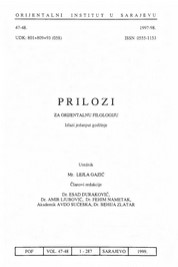
Keywords: Croat peasantry; The Ottoman government; Tax registers; 16th-17th centuries; Economic activities;
The Analysis of "testing samples" from the Ottoman detailed tax register for the region of Dalmatinska Zagora, Eastern Lika, Slavonija and Western Srijem (years 1528, 1550, 1565, 1568 and 1604), supplemented by the statements of the other, Turkish and non Turkish sources, allows preliminary conclusions to be made on some essential characteristics of the Ottoman fiscal policy and its consequences on economic and social fields. So, on the one hand, a steady opinion is being confirmed that, by their administrative measures, the Ottomans diđ not drastically changed the way of life and the forms of the economic activities of the peasant population they happened to find on the ground, but on the other hand, starting from the interests of the centralized state which was bound to ensure income to the members of military - bureaucratic group (spahijas etc?) in a rational way, they levied proportionally higher taxes to those branches of farmer production which did not represent the existential basis of the population, and very little, almost no taxes on some fundamental products of a certain region. It appears that surpluses in sheep farming in Dinara region, pig farming in Panonia region and in vineyards in both these regions, as the basis for life, were assigned (after a portion was sold at the market) to cover cash taxes to the State, starting from the headmoney to various extraordinary levies that were constantly growing and transformed into the money amounts.
More...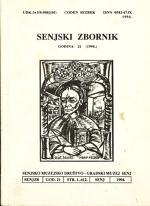
Keywords: Hrvatski Sokol; Senj;
Anläßlich der 105. Jahresfeier des Vereins Hrvatski Sokol in Senj und auf Grund des gesammelten Materials und der AuskUnfte in der kurzen Geschichte des Vereins (Sammeln aus des Vergangenheit des Vereins Hrvatski Sokol), gedruckt anläßlich der 40. Jahresfeier dieses Vereins 1929), entreißt der Autor der Vergangenheit eine ehemalige bedeutungvolle Kultur- und Sporttätigkeit der Stadt Senj.
More...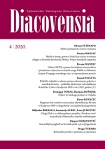
Keywords: Croatian Spring; Osijek; socio-political organizations; Matica hrvatska; students; socialist Yugoslavia;
The article analyzes the events that can be subsumed under the common denominator of the Croatian Spring in the local Osijek area. The introductory part starts from the terminological and substantive definition of the general phenomenon of the Croatian Spring, recognizing several events that preceded it and enabled its development. This is followed by a proposal for the periodization of the Croatian Spring with three phases and the presentation of its three focal points, with local Osijek equivalents (the »reform« wing of the Municipal Committee of the League of Communists of Croatia in Osijek – OK SKH Osijek, Matica hrvatska Branch Osijek – OMH Osijek, and the Students League of Osijek – SSO). In the continuation of the article, the individual chapters analyze the events within the Osijek socio-political organizations, OMH Osijek and the Osijek student movement, which can be put in the context of the Croatian Spring. It establishes a direct connection of the Spring movements in Zagreb with those that will follow in Osijek, through various common communication channels, such as the participation of members of the SKH Central Committee in sessions of local socio-political organizations, or the public lectures of distinguished members of MH organized by OMH Osijek. In the end, it also turned out that the situation in Zagreb was largely copied in the Osijek area during the time of the culmination of the Croatian Spring, taking into account socio-political organizations, MH and students, with the only exception of the later emergence of Spring ideas in Osijek than in Zagreb.
More...